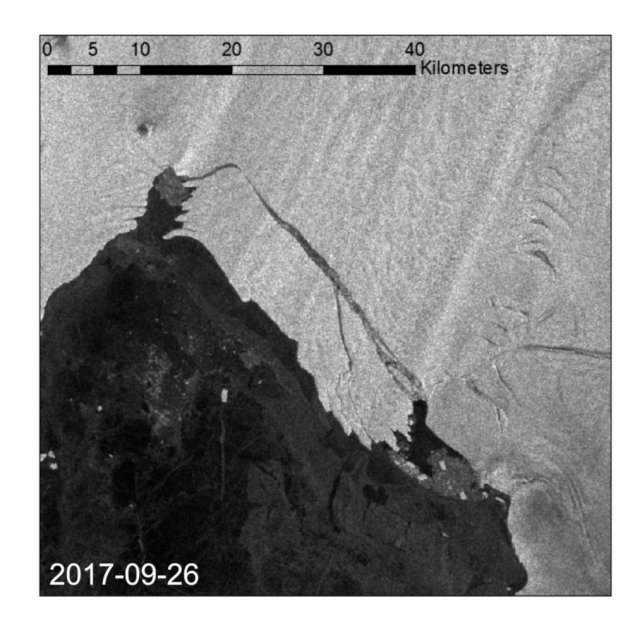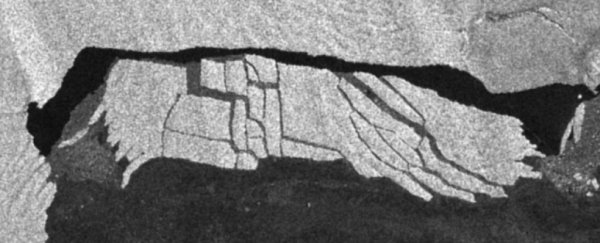When the fastest melting glacier in Antarctica surrenders itself to the ocean, the results can be pretty dramatic to watch – and, as scientists explain, worrying.
Researchers have just released a new animation depicting the ongoing disintegration of a vast Antarctic iceberg four times the size of Manhattan, which calved from the Pine Island Glacier two months ago and has been breaking up into ever smaller fragments ever since.
The iceberg, which covers approximately 267 square kilometres (103 square miles), broke free of the glacier in West Antarctica in late September, and was initially expected to drift far out into the Southern Ocean before fracturing.
That didn't happen though, with the huge chunk of unstable ice thought to have been impeded by a layer of thick sea ice, ensuring that the breakup is taking place only kilometres from the glacier it abandoned.
 (ESA/BAS)
(ESA/BAS)
As the animation above shows – assembled from observations taken by the European Space Agency's Copernicus Sentinel-1 satellite – the iceberg has divided into several discernible fragments of varying size since September 26.
While the fracturing process itself might seem unremarkable, the way the iceberg broke free from the glacier was not, scientists say, and could signal an alarming new precedent in calving processes.
"What we're witnessing on Pine Island Glacier is worrying," explains marine geophysicist Robert Larter from the British Antarctic Survey.
"We're now seeing changes in the calving behaviour of the ice shelf, when for 68 years we saw a pattern of advance and retreat resulting in the calving of a single large iceberg which left the ice front to approximately the same place."
Unlike those events, which effectively replenished the footprint of the up-to-60 metre tall (197 ft) ice front, continued thinning of the glacier as a whole has produced what scientists fear may be evidence of a new era of structural instability.
Pine Island Glacier: the movie. From Oct 2014 to recent calving in 108 #sentinel1 images @CopernicusEU @ESA_EO pic.twitter.com/oYKvelCKPd
— Stef Lhermitte (@StefLhermitte) October 13, 2017
"What's both interesting and of concern is the lines along which the iceberg has broken follow the pattern of crevasses developed in the ice shelf that it calved from," Larter says.
"This change of behaviour might reflect the crevasses within the ice shelf having an increasing influence on the spacing and pattern of iceberg calving as a result of the thinning that has taken place over the past few decades."
This calving signature – if that's what it is – could foretell a disturbing trend in the Pine Island Glacier, which accounts for about a quarter of all of Antarctica's ice loss, thought to be some 40 billion tonnes of ice each year.
That equates to approximately 1 millimetre of sea level rise every eight years, which might not sound too alarming – but if the whole of Pine Island Glacier were to melt, we could be looking at around 50 centimetres (1.7 feet) of potential global sea level rise.
Of course, no one's predicting such a catastrophe is going to happen right away, but scientists are saying the new signs of calving behaviour aren't a welcome development.
"We predicted that the rifting would result in more frequent calving, which is what's happening here," glaciologist Ian Howat of Ohio State University told The Washington Post in September when the iceberg cut loose.
"If new rifts continue to form progressively inland, the significance to ice shelf retreat would be high."
The thing is, we might not have long to wait to find out if the working hypothesis is on the money.
Another series of thin cracks about 3 kilometres inland from where this iceberg broke free was detected in March.
It might not be significant, but if it is, those fractures could represent the contours of the future ice shelf, by which time, the ocean will again be imperceptibly deeper.
"We don't have any more recent data to see what its status is," Howat told The Washington Post.
"But this means that we would expect another calving event very soon."
